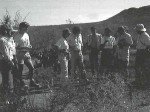In October 1994, representatives from the LTER Network and the National Science Foundation (NSF) traveled to the Mapimi Biosphere Reserve Research Station in Durango, Mexico, to discuss with Mexican ecologists the prospects of developing long-term research collaborations. The U.S. group was led by Jim Gosz, representing NSF’s Division of Environmental Biology, and consisted of LTER co-principal investigators from Sevilleta (Bob Parmenter, James Brunt and David Lightfoot), Jornada (Laura Huenneke), and NSF’s International Programs (Emily Rudin). The Mexican contingent was directed by Dr. Carlos Montana, from the Instituto de Ecología, Xalapa, Veracruz, and consisted of scientists from the Xalapa institute (Oscar Briones, Sonia Gallina, Jorge Lopez Portillo, and Maria del Carmen Mandujano) and the Instituto de Ecología, Durango (Olivier Grunberger, Lucina Hernandez, and Eduardo Rivera).
The rationale for conducting the workshop was based upon the potential research opportunities along the environmental gradient across the Chihuahuan Desert from New Mexico to central Mexico. In view of the research interests of the scientists at the Jornada and Sevilleta LTER sites, and the geographic positions of these sites at the northern boundary of the Chihuahuan Desert, it has become desirable for U.S. LTER scientists to collaborate with a research site in the central Chihuahuan Desert. Such a site would provide a reference point for many studies concerned with ecological responses to climate dynamics and land-use changes (the major themes of the two LTER programs). In addition, the potential accelerated development of the U.S.-Mexico borderlands under the North American Free Trade Agreement will demand greater quantities of ecological data for use by policymakers and land managers; hence, a collaborative effort by U.S. and Mexican ecologists will prove useful in developing environmental data sets.
The workshop consisted of a series of presentations on various LTER-type research studies being conducted by the U.S. and Mexican scientists in the Chihuahuan Desert. In addition, the group undertook several field trips to the Mapimí research sites, during which discussions took place on potential collaborative studies. The final day was devoted to developing two research proposals for cross-site studies: one study on desert shrub populations and another on plant-animal interactions or influences on ecosystem processes. These proposals have now been written and will be submitted to NSF and the Mexican CONACYT in April 1995 for consideration of funding.
For more information: Bob Parmenter (bParmenter@LTERnet.edu) or David Lightfoot (dLightfoot@LTERnet.edu), Sevilleta or Laura Huenneke (lHuenneke@LTERnet.edu), Jornada

 Enlarge this image
Enlarge this image